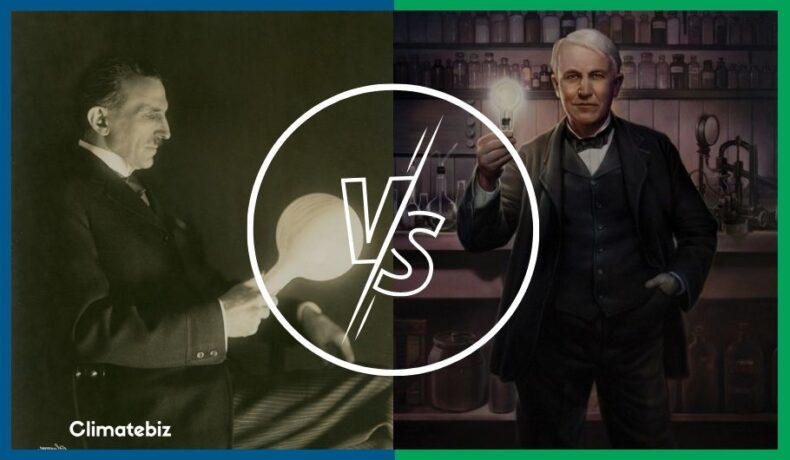Usually, we write about sustainable technologies, but today we’re going to discuss some history: Nikola Tesla vs. Thomas Edison.
Although it sounds like two inventors battling it out in a boxing arena, the “battle of currents” was a difference of opinion on the superiority of AC vs. DC electrical systems.
The period in which these events transpired is probably the most fascinating in the history of electrification.
Tesla and Edison are great scientists who revolutionized the world we currently enjoy. Edison was one of the most notable inventors in the 20th century that recognized the potential of solar power for energizing the grid. In contrast, Tesla brought the likes of the AC motor, wireless communication, and much more to this world.
Time to give you a glimpse into the lives of these two incredible inventors!
Table of Contents
Nikola Tesla Vs. Thomas Edison
| Thomas Alva Edison | Nikola Tesla | |
|---|---|---|
| Date of Birth | Feb 11, 1847 | July 10, 1856 |
| Place of Birth | Ohio, USA | Smiljan, Croatia |
| Citizenship | American | Austrian – American |
| Languages | English | English, Serbo-Croatian, Czech, Italian, French, German, Latin, Hungarian |
| Height | 5 ft. 10 in (178 cm) | 6 ft. 2 in (188 cm) |
| Eye Color | blue-green | blue |
| Hair Color | Brown Dark blond | Jet black |
| Education | Self Educated | The Graz University of Technology (drop out) |
| Discipline | NA | Electrical and Mechanical Engineering |
| No of Patents | 1,093 | 230 to 300 |
| Significant Inventions | Electric lamp | AC Generator |
| Phonograph | Induction motor | |
| Motion pictures | Tesla coil | |
| Microphone | Wireless transmission |
It might surprise you to know that Nikola Tesla initially worked for Thomas Edison at the Continental Edison Company in Paris, France, back in 1882. During this time, Tesla started showing his brilliance, designing newer versions of DC dynamos and motors.
In 1884, Tesla emigrated to the US to work at the Edison Machine Works. He worked there for the next 6 months before leaving the company to carve a path for himself.
It was after this period that their rivalry began — Tesla worked to develop AC technologies while Edison’s whole business model relied on the DC electrical system. Edison would do everything in his power to discredit the AC transmission system (discussed later on).
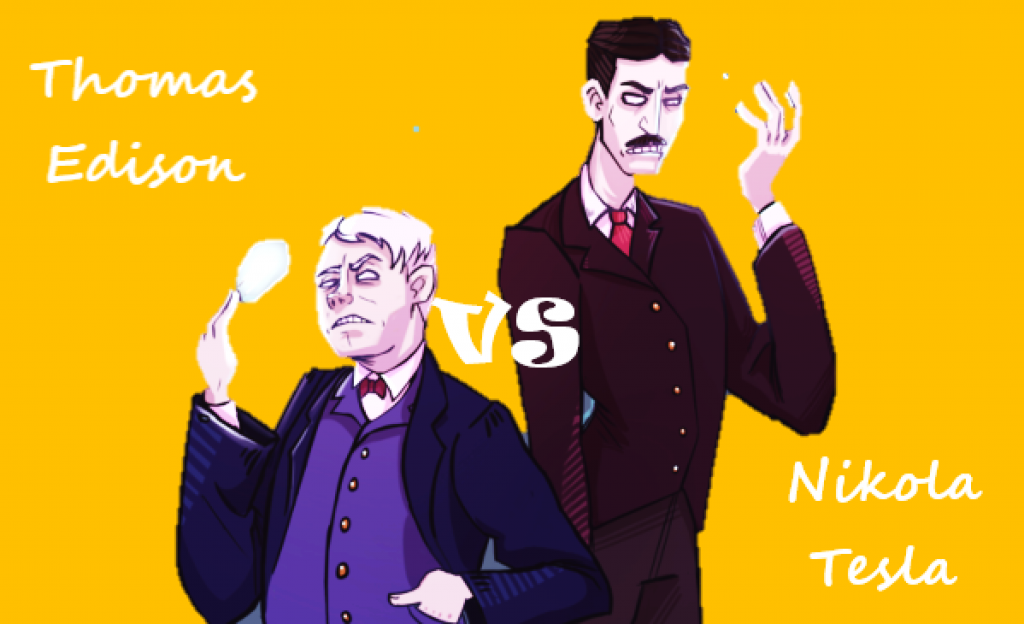
Before we go any further, let’s look at their early childhood:
Thomas Edison: Early life
Thomas Edison was born in 1847 in Ohio, USA. His mother (a school teacher) homeschooled him due to his inability to study in a public school.
He blamed this on his hearing problems, although historians now believe Edison might have had ADHD — Attention-Deficiency/Hyperactivity Disorder.
As a child, he developed a great sense of entrepreneurship, and at the age of 13, he made profits from his ventures selling candy and newspapers on the railroads. He then became a telegraph operator, and in his free time, he experimented with electricity.
From here, this boy went on to establish 14 companies, including General Electric, one of the world’s biggest conglomerates.
Now, let’s look into the early life of Nikola Tesla, the man behind the current grid system.
Nikola Tesla: Early Life
Nikola was born on July 10, 1856, in Smiljan, Croatia (9 years younger than Edison).
Unlike Edison, Nikola had formal education and even went on to study engineering at the Graz University of Technology. Although he never finished his higher education, he became fascinated with electricity and motors through his professor Jakob Poschl.
At 25, Tesla moved to Hungary to work at a telegraph company.

Source: Wikimedia
It’s interesting to note that both Edison and Tesla started their careers at telegraph companies.
How Did Nikola Tesla & Thomas Edison Meet?
Although Tesla had been working at Edison’s company back in Europe, it was only after he came to the U.S. that he met Edison in person.
One such event that Tesla mentions in his autobiography occurred during a repair job on the ocean liner SS Oregan. It was noted that Tesla even heard Edison remark on his performance to his assistant on SS Oregan,
“Batchellor, this is a damn good man!” – Edison
tesla Universe
Tesla later went on to design a new arc lightning system for Edison Machine Works. Many believe that Tesla quit in 1884 due to the shelving of this project or compensation issues with the company.
He formed his own company — Tesla Electric Light and Manufacturing — and went on patenting his version of the arc lighting system.
Why Did Tesla Vs. Edison Rivalry Begin?
Supposedly for Tesla, the rivalry began after he had to quit Edison Machine Works. In contrast to Edison, Tesla became a threat when his AC technology inventions started to gain traction.
Following his resignation, Tesla developed a polyphase AC induction motor in 1887. He and his partners then negotiated a deal with George Westinghouse (Edison’s business competition) to license this technology for commercial use.
In 1889, Tesla had made enough money to have his own independent lab in New York; this is where he carried out most of his later inventions.
Tesla’s AC motor and generator became the reason for the demise of the DC electric system (which will be discussed later on).
Tesla Vs. Edison (Alternating Current Vs. Direct Current)
As we’ve already mentioned, there were two parallel electric power transmission systems, AC and DC. It’s important to note that AC power was not something Tesla introduced to the world; it was already available in Europe. However, Tesla’s invention allowed for the commercial acceptance of AC over DC.
What Are AC And DC?
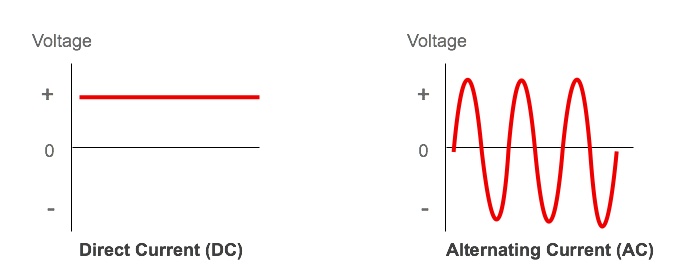
Source: Loick Jouaud (2020)
Without getting too technical, all the material in the world is composed of atoms, and electrons surround atoms. The free movement of electrons — negatively charged particles — generates electricity.
Alternating current (AC) has a periodic change in magnitude and direction, while Direct current (DC) has a unidirectional and stable current.
The major advantage of DC is safety (it requires less insulation). AC’s advantage is its transmissibility and efficiency.
Edison’s DC-based Power System Vs. Westinghouse’s AC-based Power System
In 1886, George Westinghouse introduced a rival AC current-based transmission system. It’s important to note that the DC-based transmission system was already available in 1884. However, it had flaws:
- DC power was only feasible for high-density areas
- DC power required thick, expensive wiring with high line losses
- DC power could not be transmitted to ranges higher than 1 mile
An AC system (after the invention of transformers) solved all these issues while being safe for consumers after using a “Step down” transformer.
The salient features of AC power included:
- AC power provided longer-range transmission of electricity
- AC power used thinner transmission wires
- AC power companies could tap into the unserved market left by Edison’s DC power network
So, what role did Tesla play in this battle of market share between three companies: Edison General Electric, Thompson-Houston Electric Company, and Westinghouse Electric & Manufacturing Company?
Tesla believed that DC-based power generation had inherent flaws, including the previously mentioned transmutability issues and line losses. He developed a new type of arc lightning at Edison Machine Works.
After finding his own company, he invented the first AC motor and worked on the transmission of AC technologies, including the Tesla coil and other wireless transmission devices.
It was Tesla’s AC induction motor that forced the end of Edison’s DC-based power system (We will discuss this in the inventions section).
The Controversy Surrounding AC Safety
Edison lobbied against the AC power system while spreading propaganda on safety concerns over its use. Furthermore, his company men showcased how AC was a dangerous form of transmission by publicly electrocuting animals.
Back in 1903, Edison staged the electrocution of Topsy the elephant at Luna Park Zoo.
Who Had The Better Inventions?
This section might be the best way for you to evaluate the Nikola Tesla vs. Thomas Edison debate.
Before we can compare inventions, let’s discuss a few of these inventors’ significant inventions.
We’ve devised this section to take you through the years of inventions by both scientists, starting with the Phonograph, Edison’s first major breakthrough.
Phonograph — 1877

It was Thomas Edison who invented the Phonograph in 1877. This device could record sound by noting the waves and etching it on a disc, which could be played again. This became the impetus for modern audio recorders and disk players.
Incandescent Light Bulb — 1878
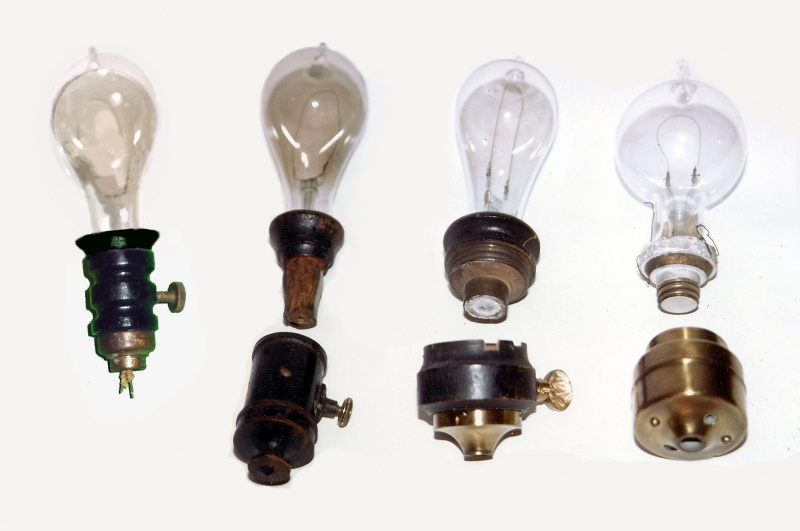
Source: Richard Warren Lipack / Wikimedia Commons
Light bulbs had existed long before 1878, but only arc lightning bulbs were commercially viable. In 1878, Edison came up with a carbon filament DC incandescent light bulb that could last 1200 hours. This invention led to the Edison Electric light company and widespread acceptance of light bulbs over the gas lamps.
Electric Power Distribution — 1880
In 1880, Edison patented a system for electricity distribution and, in 1882, formed the first investor-backed electric utility company. Initially, he was supplying 110 volts DC to 59 customers in Manhattan. By 1883, there were overhead DC cables and street lamps across major cities in America. Finally, in 1892, Edisons General Electric and Thompson-Houston Electric Company merged to form the General Electric of Forbes 500 that we know today.
Tesla’s AC Induction Motor — 1888
As a student, Tesla had already conceived the idea of an AC induction motor back in Europe. But, it was in 1888 that he filed for the patent for his revolutionary induction motor that paved the way for the application of an economically feasible AC power system.
Tesla sold its patent to Westinghouse, and its first demonstration took place at the Worlds Columbian Exposition held in 1893. Then, in 1895 the world’s first hydroelectric plant was established at the Niagara falls, using Tesla’s AC Induction generator.
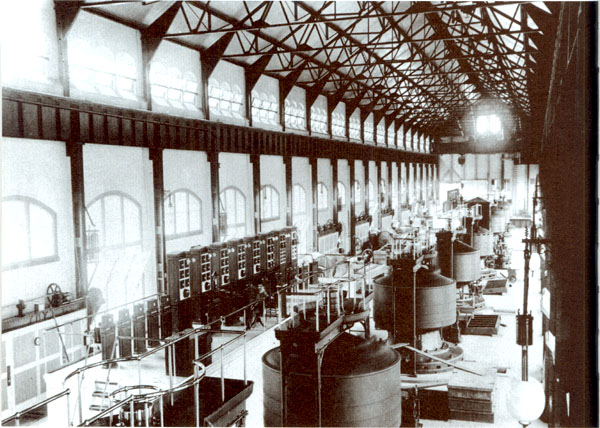
Source: Tesla-Westinghouse Niagara Falls Power Plant (1895)
Wireless Power — 1890
Tesla showed the world that power could be transmitted wirelessly, illuminating a vacuum tube based on near-field induction. Although this was a dream, he was unable to produce something commercially viable through this discovery.
Commercial Fluoroscope — 1890s
Edison produced the first commercially viable fluoroscope that uses X-rays to take radiographs. Although he had abandoned the project owing to the dangers of X-rays, his designs are still in use.
Motion Pictures — 1891
Later, Edison worked on motion pictures and exhibited his kinetograph and kinetoscope in 1891. One device is for capturing motion pictures, while the other allows a single person to view a captured motion picture.
Tesla Coil — 1891
Tesla developed an electrical resonant transformer circuit to create high volt, low current AC electricity. Its principle is that of a step-up transformer, and it later found application in leak detection in vacuum chambers and arc welding.
Radio Remote Control and “Teleautomatics” — 1898
Towards the end, Tesla developed an electrical resonant transformer circuit to create high volt, low current AC electricity. Its principle is that of a step-up transformer, and it later found application in leak detection in vacuum chambers and arc welding.
Based on these inventions and innovations, it would be correct to say that Thomas Edison and Nikola Tesla were extraordinary individuals who have done more for physics than many notable inventors of their time.
Tesla can be attributed to the modern-day AC-based power generation and grid system, while Thomas Edison innovated the incandescent light bulb, audio recording, and motion pictures.
Who Was More Successful, Tesla Or Edison?
If we were to measure their success from a material perspective, Thomas Edison wins by a long shot. Tesla practically died penniless and in debt, while Thomas Edison was one of the most successful inventor business tycoons of his time.
While Edison worked to perfect already discovered technologies like the DC light bulb, and motors, he did come up with the phonogram, the first electric grid for public use, and motion pictures.
Whereas, for Tesla, it was always about doing something new. He invented the AC motor and power generation — we depend on this technology for our power. He also worked on technologies far ahead of their time, like radio control and wireless energy transmission.
In Summary
Tesla might have an edge when it comes to inventions, as his AC-based generation and electric power system dominate the world. Still, the world would have been at a loss without the initial push from Edison and his business prowess.
Tesla Vs. Edison: Who Was The Most Educated?
Tesla wins this round vs. Edison, as Edison didn’t even go to a high school for formal education. Nonetheless, he was homeschooled by a mother who was a school teacher. Also, he learned the sciences by himself through experimentation, and his business prowess came from his years of experience in the streets.
Unlike Edison, Tesla went to a formal school and later attended the Graz university to study for his engineering degree. He did, however, drop out mid-way due to failing in many subjects.
Historians believe that it may be due to his disinterest in continuing there. He developed an interest in electricity at his university, and it was here that he imagined his induction motor.
Final Thoughts
We hope this comprehensive discussion on “Nikola Tesla vs. Thomas Edison” provided valuable insights into the lives of these extraordinary scientists. For us, it’s humanity that has benefited from this battle between two great scientists. There would have been no Tesla if an employee of Edison Machine Works did not take Tesla to the US.
All in all, the world needs both Nikola Tesla and Thomas Edison for progress. Who in your opinion fares better? Do let us know in the comments.

